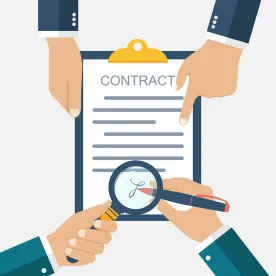Recent press coverage concerning transparency and oversight with respect to the Paycheck Protection Program (“PPP”) has largely focused on PPP borrowers and the ability of Congress and federal inspectors general to obtain PPP borrower data from the Small Business Administration (“SBA”). The SBA has announced that it will release certain information about the loans PPP lenders issued. However, given limitations on the information that will be disclosed, Congress and federal inspectors general may also seek detailed PPP borrower and other information directly from lenders. The latter scenario could lead to requests for PPP lenders to provide data and respond to pointed questions. This memorandum outlines issues which lenders may wish to consider in anticipation of such information requests.
Treasury Secretary Steven Mnuchin surprised many on June 10, 2020, when he stated that details about PPP borrowers and their loans was “proprietary” and “confidential,” and would not be disclosed.1 This surprised many PPP borrowers because the SBA PPP loan application states that borrower information will be “automatically released.”2 However, after several congressional leaders urged the SBA to provide greater transparency, the SBA and the Treasury Department agreed on June 19, 2020, to make certain PPP loan data public. Specifically, for PPP loans of $150,000 or more, the SBA will disclose the business names, addresses, NAICS codes, zip codes, business type, demographic data, non-profit information, jobs supported and loan amount ranges.3 The SBA estimates that this will account for nearly 75 percent of the loan dollars approved.
While the practical effects of the SBA’s announcement remain uncertain, PPP lenders should consider how to prepare for questions and scrutiny about the criteria and the processes they used to award the loans. Questions might come from Congress, inspectors general, regulatory agencies, law enforcement agencies, investigative journalists, or the public. Outlined below are key areas of likely questions and potential risks lenders may wish to consider.
1. Lenders should consider whether they have put in place systems, policies, and procedures that adequately respond to recently issued SBA regulations and guidance.
Since the inception of the PPP, the SBA has issued a dozen Interim Final Rules and 48 FAQs. Many of the rules and FAQs significantly alter lenders’ previous understandings of their responsibilities under the PPP. Lenders should consider how effectively they have distilled the SBA’s rules and guidance into systems, policies, and procedures that are compliant with the SBA’s expectations.
In particular, lenders may wish to evaluate the SBA’s June 1, 2020 Interim Final Rule, which details the level of review that the SBA expects lenders to conduct on PPP borrowers’ applications for forgiveness.4 Lenders may also want to consider whether they carried out an appropriate level of review of PPP borrowers’ initial applications, and whether the advice lenders gave to applicants concerning PPP loan eligibility and allowable uses of loan proceeds was, and remains, correct under the SBA’s rules and guidance.
It is notable that under the latest Interim Final Rule, lender processing fees are subject to clawback if a lender has not fulfilled its obligations under the PPP regulations.5
2. Lenders should expect questions about the locations and demographics of the PPP borrowers which they approved and what steps, if any, each lender took to ensure that PPP loans were issued to small businesses, to borrowers in underserved and rural communities, and to women- and minority-owned businesses.
From the inception of the PPP, numerous questions have arisen about whether the program was benefiting appropriate borrowers. Public perceptions and the text of the CARES Act and SBA guidance have not always been aligned on who the “right” type of borrower is.6 As a result, lenders may face questions about how, where, and to whom they lent.
3. Lenders should expect questions about whether they prioritized some PPP applications over others, and if so, how and why.
Early SBA guidance to lenders made clear that lenders were generally not required to conduct new customer identification processes for existing customers who applied for PPP loans.7 This made it less cumbersome and time-consuming for lenders to approve PPP loans to their existing customers. One question that lenders may be asked is whether they prioritized loans to existing customers to the detriment of applicants who were not existing customers.
4. Lenders should be aware that scrutiny of their PPP borrowers could lead to questions about whether a lender adequately met its Bank Secrecy Act / Anti-Money Laundering (“BSA/AML”) and Office of Foreign Assets Control (“OFAC”) sanctions obligations.
Lenders were not required to refresh or re-verify the identity of their existing customers, in part on the assumption that each lender had already vetted existing customers in order to comply with BSA/AML and OFAC requirements.
But some lenders’ existing customers may have been vetted years or even decades ago. Lenders may wish to consider whether their BSA/AML and OFAC programs are currently adequate and up-to-date, and whether the information which they used to conduct due diligence on a specific existing customer remains adequate and up-to-date.
Lenders may also wish to consider whether the BSA/AML and OFAC vetting that they applied to PPP applicants who were new customers was adequate. This is especially true for lenders that did not have a BSA/AML program (or an agreement to rely on another financial institution’s BSA/AML program) in place prior to issuing PPP loans.8
In addition, lenders may wish to consider, with the benefit of hindsight, whether pressure to disburse PPP loans caused them to cut corners in any of their underwriting, BSA/AML, or OFAC processes. Similarly, lenders may wish to evaluate whether they are now adequately monitoring their PPP borrowers for suspicious activity, including by reviewing the information in PPP borrower loan applications and applications for loan forgiveness, and the borrower’s financial transactions following loan disbursement.
If any shortcoming is identified, lenders should consider both addressing the shortcoming and potentially disclosing the remedied deficiency to their regulator before a regulatory audit or inquiry occurs.
1 See, e.g., TIME, Names of Small-Business Borrowers From Paycheck Protection Program Won't Be Released, Mnuchin Says (Jun. 12, 2020), https://time.com/5852828/mnuchin-ppp-borrowers-names-secret/; Testimony of Secretary of the Treasury Steven Mnuchin before the U.S. Senate Committee on Small Business & Entrepreneurship, Implementation of Title I of the CARES Act (Jun. 10, 2020), https://www.sbc.senate.gov/public/index.cfm/hearings?ID=C0E44E40-CC47-469C-9404-BE3EB4020AA0, embedded video at 1:23:48 (“as it relates to the names and amounts of specific PPP loans we believe that that’s proprietary information and in many cases for sole proprietors and small businesses is, is confidential information, so the reason why we’re not disclosing the names and individual amounts, unlike in the 7(a) program, is because of that issue.”).
2 U.S. Small Business Admin., Paycheck Protection Program Borrower Application Form, SBA Form 2483 (04/20), https://www.sba.gov/sites/default/files/2020-04/PPP%20Borrower%20Application%20Form.pdf (“Information about approved loans that will be automatically released includes, among other things, statistics on our loan programs (individual borrowers are not identified in the statistics) and other information such as the names of the borrowers (and their officers, directors, stockholders or partners), the collateral pledged to secure the loan, the amount of the loan, its purpose in general terms and the maturity.”).
3 Press Release, U.S. Small Business Admin., SBA and Treasury Announce Enhanced Transparency Regarding the Paycheck Protection Program (Jun. 19, 2020), https://www.sba.gov/about-sba/sba-newsroom/press-releases-media-advisories/sba-and-treasury-announce-enhanced-transparency-regarding-paycheck-protection-program.
4 U.S. Small Business Admin., Interim Final Rule, Business Loan Program Temporary Changes; Paycheck Protection Program—SBA Loan Review Procedures and Related Borrower and Lender Responsibilities § III, 85 Fed. Reg. 33010 (Jun. 1, 2020).
5 Id at § III.3.c.
6 See, e.g., Cadwalader, Wickersham & Taft, COVID-19 Update: These Are Not the Droids You’re Looking For: The “Wrong” Type of PPP Borrowers May Need to Repay Their Loans or Prepare for an Audit (May 4, 2020, available at https://www.cadwalader.com/uploads/cfmemos/74d4010f9aacae2c09e27632fdaa625d.pdf.
7 U.S. Small Business Admin., Interim Final Rule, Business Loan Program Temporary Changes; Paycheck Protection Program § III.b.iv.I, 85 Fed. Reg. 20811, 20815-16 (Apr. 15, 2020).
8 Id at § III.b.iv.II.






 />i
/>i
